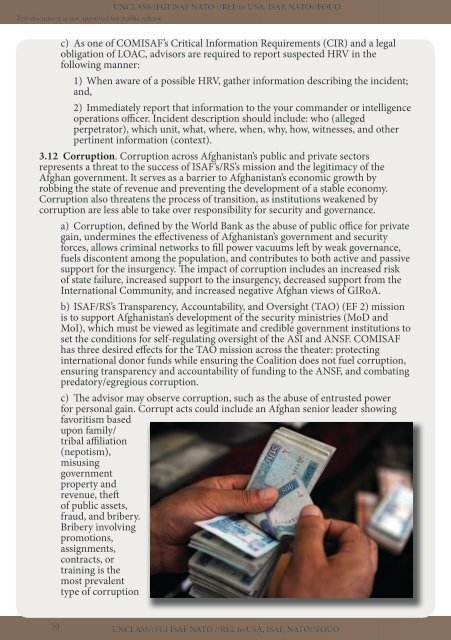20140927_NIU_CJ7_TREX_SFA guide 3.1
20140927_NIU_CJ7_TREX_SFA guide 3.1
20140927_NIU_CJ7_TREX_SFA guide 3.1
Create successful ePaper yourself
Turn your PDF publications into a flip-book with our unique Google optimized e-Paper software.
UNCLASS//FGI ISAF NATO //REL to USA, ISAF, NATO//FOUO<br />
This document is not approved for public release<br />
c) As one of COMISAF’s Critical Information Requirements (CIR) and a legal<br />
obligation of LOAC, advisors are required to report suspected HRV in the<br />
following manner:<br />
1) When aware of a possible HRV, gather information describing the incident;<br />
and,<br />
2) Immediately report that information to the your commander or intelligence<br />
operations officer. Incident description should include: who (alleged<br />
perpetrator), which unit, what, where, when, why, how, witnesses, and other<br />
pertinent information (context).<br />
<strong>3.1</strong>2 Corruption. Corruption across Afghanistan’s public and private sectors<br />
represents a threat to the success of ISAF’s/RS’s mission and the legitimacy of the<br />
Afghan government. It serves as a barrier to Afghanistan’s economic growth by<br />
robbing the state of revenue and preventing the development of a stable economy.<br />
Corruption also threatens the process of transition, as institutions weakened by<br />
corruption are less able to take over responsibility for security and governance.<br />
a) Corruption, defined by the World Bank as the abuse of public office for private<br />
gain, undermines the effectiveness of Afghanistan’s government and security<br />
forces, allows criminal networks to fill power vacuums left by weak governance,<br />
fuels discontent among the population, and contributes to both active and passive<br />
support for the insurgency. The impact of corruption includes an increased risk<br />
of state failure, increased support to the insurgency, decreased support from the<br />
International Community, and increased negative Afghan views of GIRoA.<br />
b) ISAF/RS’s Transparency, Accountability, and Oversight (TAO) (EF 2) mission<br />
is to support Afghanistan’s development of the security ministries (MoD and<br />
MoI), which must be viewed as legitimate and credible government institutions to<br />
set the conditions for self-regulating oversight of the ASI and ANSF. COMISAF<br />
has three desired effects for the TAO mission across the theater: protecting<br />
international donor funds while ensuring the Coalition does not fuel corruption,<br />
ensuring transparency and accountability of funding to the ANSF, and combating<br />
predatory/egregious corruption.<br />
c) The advisor may observe corruption, such as the abuse of entrusted power<br />
for personal gain. Corrupt acts could include an Afghan senior leader showing<br />
favoritism based<br />
upon family/<br />
tribal affiliation<br />
(nepotism),<br />
misusing<br />
government<br />
property and<br />
revenue, theft<br />
of public assets,<br />
fraud, and bribery.<br />
Bribery involving<br />
promotions,<br />
assignments,<br />
contracts, or<br />
training is the<br />
most prevalent<br />
type of corruption<br />
30<br />
UNCLASS//FGI ISAF NATO //REL to USA, ISAF, NATO//FOUO


